西红柿的味道和质地,拔除直接y from a backyard vegetable garden, combine wholly into an experience that cannot be explained in words. Subtly sweet, just-right acidity, firm but yielding juicy flesh. That same tomato, stewed slowly and lovingly by your old-world Nonna, becomes a sauce that no jar could ever match.
It’s not a miracle. It’s a 39 cent pack of seeds, tended by hand under the right ratio of sun, water, and soil – low tech, and thousands of years old. I’ll bet, however, that most of you have never experienced arealtomato, still dusted with earth and worthy of eating whole like an apple.
This simple pleasure was one relatively unavailable in urban centres for much of the 20th century. Its doppelgänger, the supermarket tomato, more outwardly attractive and abundant than its garden counterpart, contains none of its inner beauty.
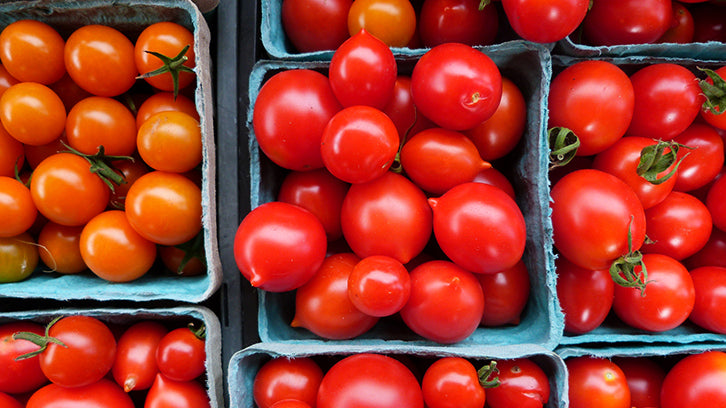
photo:Flickr
Mass production, long travel-times, and scientific nips and tucks were well-intended. They were efforts to bring pretty produce on a massive scale to everyone, everywhere. Now, food in the United States will havetravelled an average of 1500 to 2500 milesbefore hitting the table. It’s a trip that takes a toll – the cost to our palates is obvious, but our spiritual connection with food is the real loser.
(Re)enter the farmers’ market. The old way, made new again by a widespread culinary awakening. Pushing up like spring daisies, markets are growing steadily in number, giving urbanites a welcome break from cardboard carrots. They offer the opportunity to shake the hand of the person who cultivated the earth and tended the bees and ground the grain, cutting the miles and middlemen out of the farm-to-table equation.
A Brief History of Markets
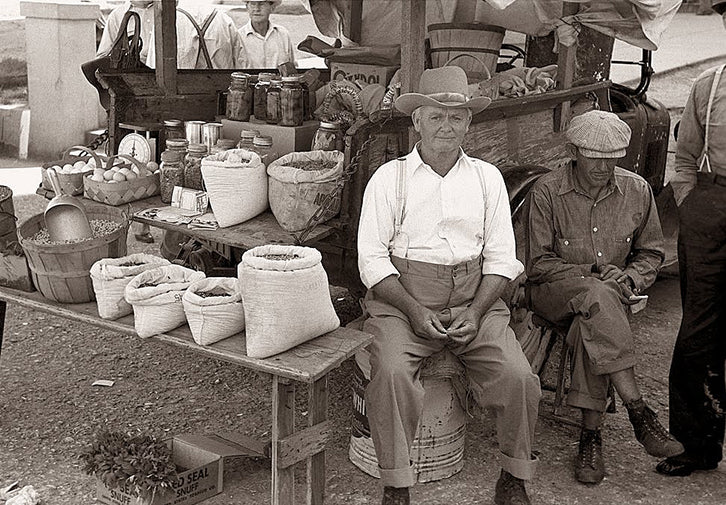
photo:老照片Blog
The first documented farmers markets arecredited to Egypt, when, about 5000 years ago, farming yields surged beyond the needs of the producers’ families. In North America, instances of these markets first appeared in1600s Boston. In 1730, city planners in Lancaster, Pennsylvaniadesigned a 120 square foot public market spacein the town’s centre, giving birth to theLancaster Central Market. The market still stands, 276 years later, making it the oldest of its kind continually running in the US.
But not all markets survived the mid-century urgency to supersize. The first grocery chains emerged in the 1850s, and, in 1930, King Kullen opened doors of its first location, becomingwidely considered the first “supermarket”. The emphasis of the supermarket boom was on volume, with little attention paid to aesthetic, driving prices down. Many local markets couldn’t compete. Other chains followed suit, amalgamating multiple small locations into larger stores. Supermarkets after-partied into the 1950s and 60s.

photo: Piggly Wiggly,Flickr
折扣和warehouse stores debuted in the 1970s, followed by mergers and consolidations that popularized one-stop shopping (think Walmart, with full grocery offerings).
Consumer distaste for anonymous factory food began to bubble up around the same time, answered by the seeds of what would later bloom into thelocavore movement, a surge in support for farmers, and the first sightings of fresh-focused chain stores like Whole Foods and Trader Joe’s in the 1980s.
Today
The number of farmers markets in the US jumped from 1755 to 5274 between 1994 and 2009 – an increase of 300% over 15 years. Local food ballooned into an11 billion dollar industry到2014年,今天,USDA Farmers Market Directorycontains 8526 listings and counting.
Defunct market spaces are nowrising from the dead, enjoying reincarnations as modern food markets, supported by the community and theincreasing government effortsto encourage local production.
In 2016, over 8500 farmers markets are operating in the US alone.

photo:Flickr
Ultimately, any burgeoning industry will find its niche on the web. The internet however, an utterly impersonal expanse of commerce, poses a challenge for a movement so dependent on human connection. This was a challenge faced, and conquered, by one passionate Shopify merchant: she recreated the spirit of the farmers’ market bypushing the producers to the forefront, telling their stories, and sharing the deep meaning behind the food they create.
Many Kitchens
Valentina Rice envisioned a world where everyone had access to food made with hands and love. Andsauce made from real tomatoes. She quit her job three years ago to launchMany Kitchens, a farmers’ market for the internetting masses.
Many Kitchens is curated marketplace of local, sustainable, and artisanal foods created by small producers. Its founder helps her partners grow their businesses while allowing them to focus on what they do best. She brings them before a community looking to “live the full journey from farm to fork”.
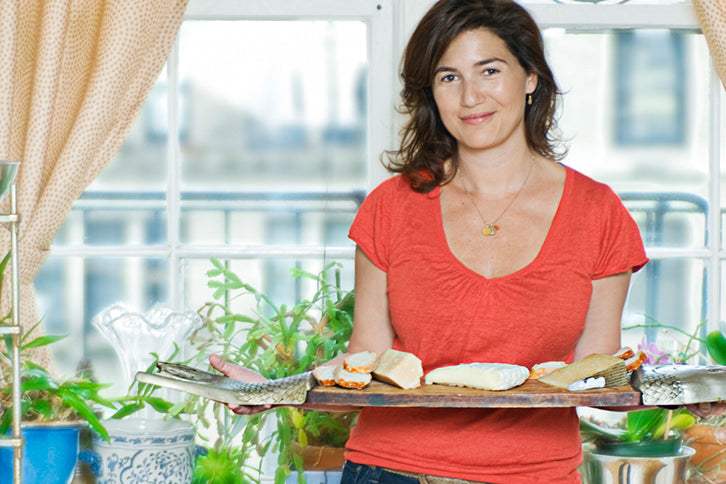
瓦伦蒂娜大米,许多厨房
The business was born out of a love of good food. Valentina spent 15 years in publishing, travelling the globe in support of books. She’d tack weekends on to business trips to explore the culinary uniqueness of each place, and, back home in New York, she’d find herself lost in the city’s abundant markets.
“I had this idea one day that came from living in New York City and having access to so many amazing foods in all of the great markets. I started thinking that the rest of the country doesn't get these and vice versa: what was going on elsewhere that we can’t access in New York? I noticed that these small batch producers in farmers’ markets had incredibly loyal followings, but perhaps not a reach beyond their local area. I decided I could try to give them a larger audience.”
She spent the first six months in research phase, polling producers, and tinkering with the site before leaving the security of her salaried job to pursue Many Kitchens full-time. Entrepreneurship didn’t run in her family, but she credits her father – a successful businessman and feminist – for instilling in her a strong work ethic and ambition. The move to self-employment had its usual hurdles.
“I worked for a very, very large global corporation and when your computer breaks down, you just call the IT department or if your printer doesn't work, it gets fixed for you. Now i’m doing everything myself – it’s just me and one part-time person. As an entrepreneur, you have to learn every single aspect of running a business.”
I've learned more in the last three years as an entrepreneur than I had in 15 years at my old job.
One of the company’s first partners was a brother and sister team behind Pipsnacks popcorn. She discovered the brand at the cusp of their success, and in turn discovered her own knack for predicting trends and winners.

Free Video Series: Ecommerce Inspiration
Feeling uninspired? Watch some of the world's most successful entrepreneurs share their best advice for new business owners.
Get our Ecommerce Inspiration video series delivered right to your inbox.
Almost there: please enter your email below to gain instant access.
We'll also send you updates on new educational guides and success stories from the Shopify newsletter. We hate SPAM and promise to keep your email address safe.
“They had launched three weeks earlier and were still making their popcorn out of their pasta pot in a small commercial kitchen. Three months after we started working with them, they were discovered by Oprah and went stratospheric. This happened with a few producers that we found early on in their careers. We felt that it was our niche – finding great products before they went nationwide. That was a big turning point, I think.”
在未来三年内,瓦伦蒂娜-一部分time employee curated a collection of hundreds of products, selecting only the best in each category from small producers across America (and beyond). Her foodie roots built a discerning palate that she stands behind – 95% of the picks are based on her own tastes, she tells me, with the rest validated by experts in the industry.
“We've always been very clear that we want to not compete within each category. Whether it be tea towels or sauces, we want to be very sure that we’ve found the best because we're so highly curated. We’ve only ever had one popcorn. We would only have one chicken pot pie. We didn't have a chocolate chip cookie on the site for so long because each one we tried just wasn't good enough. We actually finally found two and it was so hard to choose between them. So we tested and tested and tested and had everyone we know test and blind test, until we finally decided on the one we love the most.”
Ninety-five percent of the curation is based on what I like.
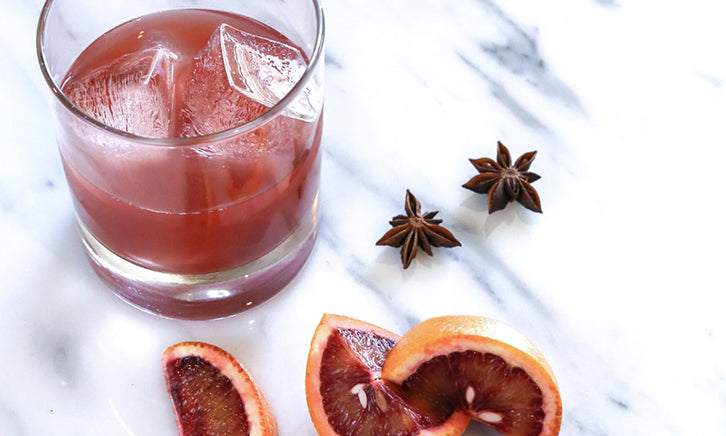
photo:Dona Chai
Product discovery is a combination of happenstance (stumbling upon gems at markets), active searching, and now, as Many Kitchen builds its reputation, via samples sent from producers.
“There’s this beach plum jam in Cape Cod that I absolutely love. I've never seen anywhere else. I don't think it exists outside of Cape Cod. It just made me think there were these hidden culinary pockets of incredible foods that are hiding around the country that I'd love to discover and share. I've started doing little expeditions, but mostly I’m researching and finding them online. Now people are finding us and sending us samples directly. We've been so lucky with receiving interesting products from everywhere."
While Valentina has ironed out most of the business kinks by now, working with small producers has its continued challenges, especially when it comes to scaling. Many Kitchens operates on a drop shipping model for about 90% of the business, leaving fulfillment in the hands of over 50 producer partners. Because of their sizes, stock shortages can and do happen.
Pipsnacks had trouble with demand after their Oprah exposure, leaving Valentina to manage the expectations of her customers.Her approach in humanizing the brands with which she works extends to her customer service strategy.
“I’ll explain (to customers) that Pipsnacks has their mother and their father and their siblings all in popping corn 24 hours a day, and that they’re doing their best to keep up with demand.”
“The great thing about this business is that I’m not working with mass-produced food, so customers understand that a human being is making their food and that sometimes they run out. I think people are incredibly patient when you give them the real story behind why their order won't be shipped for another two weeks.”
To alleviate the burden on the producers – some of whom have no ecommerce experience – she simplifies and templates the order process.Each order, along with the shipping label is emailed to the producer, allowing Valentina to track each one end to end.She also supplies Many Kitchens labels and postcards for each package, to ensure that the branding is consistent.
“We believe that producers should stay focused on what they should be focused on: making the best product they can make. We try to make the order processing and fulfillment piece so incredibly easy for them.”
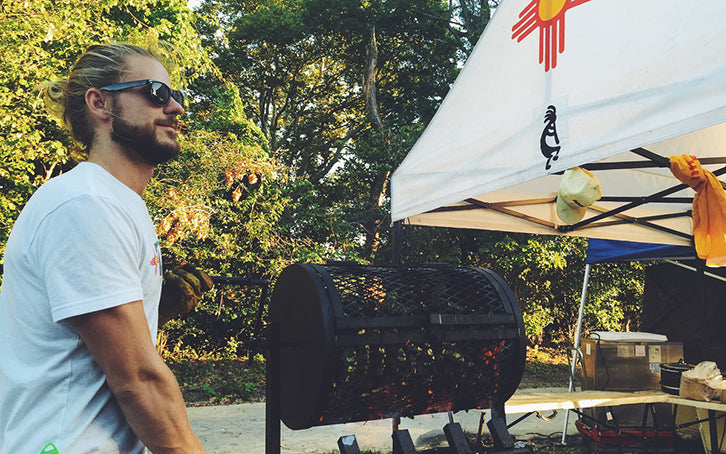

photo: Many Kitchens producers, Nate of齐亚绿色智利, Paula ofMy Sweet Brigadeiro
The remainder of the products are shipped from her own NYC apartment. She’s had to be clever with the space which also serves as her office and studio for photo shoots.
“We sell certain things that we love but for whatever reason the producer isn't able to do drop shipping so there’s stock of certain things hidden around my home. When I left my job, I sold all my bags and shoes on eBay because I didn't need them anymore. And instead, the cupboards are now filled with tea and coffee and shipping boards.”
“I can flip my apartment between office and home very quickly. We shoot the whole blog here, and all the food. We shot the cookbook here, too. There are props, backdrops, and photographic equipment hidden in the most bizarre places.”
Among the 10% of the business that is not drop shipped are Many Kitchens’ gift boxes. It’s a natural add-on for a business built on great curation. The process is, and always be manual, but Valentina feels that the personal touch helps to further humanize the brand. She invites friends over for pizza, wine, and gift box assembly, and includes a handwritten note in each box.
On The Business of Food
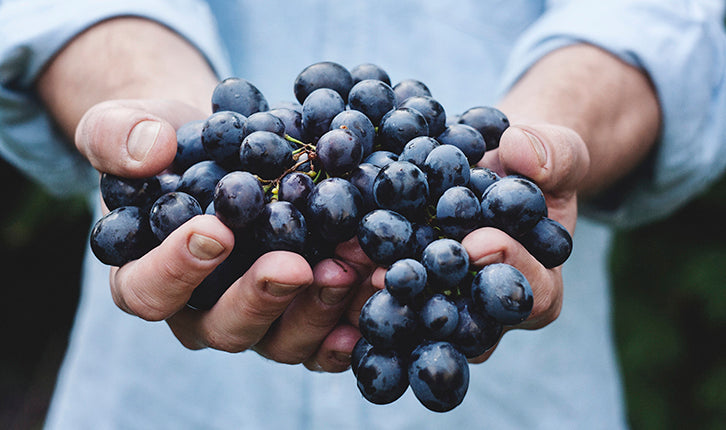
Starting a business always comes with a standard set of challenges, and those challenges are often amplified with food. Shipping, especially internationally, and inventory become doubly complicated. From her apartment in NYC, she shared with me some of her learnings over the past three years – valuable advice for any would-be entrepreneur enteringculinary ecommerce:
Marketing
Much of what the company learned about marketing a food business is attributed to trial and error.
“Google AdWordswere interesting for us – I saw the traffic increase dramatically, but the bounce rate was also through the roof. For example, if the keyword was "chicken pot pie", it was working really well and people were coming to the site, but they were immediately leaving. And I realized it doesn't work well for food because people were looking for a recipe.”
Recipes for Success
From Valentina’s AdWords experience was born a dedication toblogging regularly, with a focus on recipes which all link back to product pages. The move has helped with bounce rate and has become a powerful selling tool.
“The dream is for every product to have a recipe attached to it. We circle back if a producer hasn't had much love recently and we try and create a recipe that goes along with the product. Another great thing about recipes is showing customers how to use each item. For example, with the索马里酱汁, the date and tamarind chutney is so delicious but isn’t something everyone would immediately know how to use.”
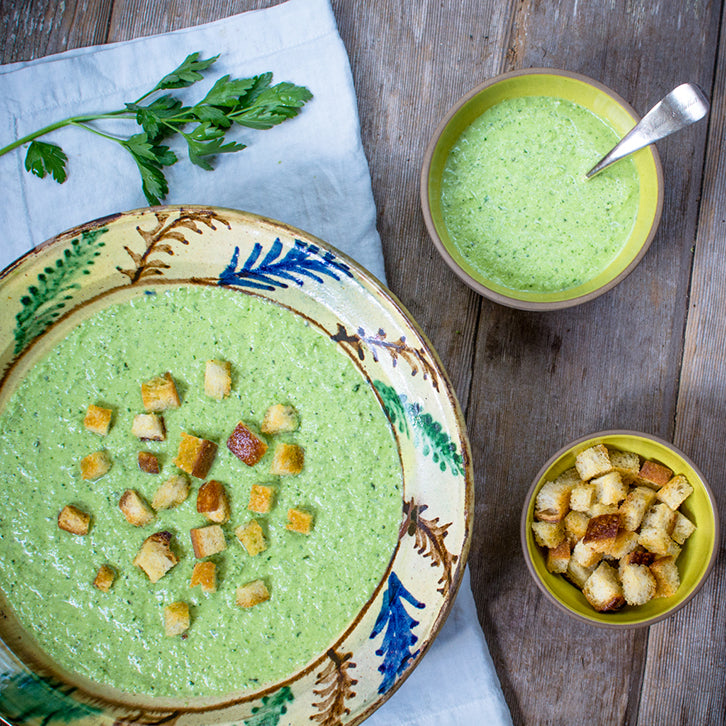
Press On
Presshas been a huge sales driver for the business, it didn’t magically happen at first. Valentina wielded her publishing knowledge to seek out press opportunities through sites based on contributor posts.
“When I've been a contributor on a publication, that has made the biggest impact on referrals. I’ve contributed to Very Short List a couple of times – they’ve now been bought by The Observer. Not only did it hugelyincrease trafficand orders, it's also how I ended up getting a book deal. We used these to tell little stories about our producers – short lists of three things that would be sent to hundreds of thousands of subscribers. Getting this exposure has contributed the most to our success.”

Visual Appeal
When taste tests aren’t an option, food purchases are often inspired by brand, packaging and visual appeal. Does it look like it will taste good? Photography for online food sales, is therefore critical, and the conventionalproducts-on-white approachmight not be the best in this case.
“有这美妙的瑞典方火腿have. If I showed it photographed wrapped in the plastic, no one's going to buy it. So, on our site, it’s pictured beautifully cooked with a glaze, sliced on a platter. It’s much more appealing, and it's easier for someone to consider buying it.”
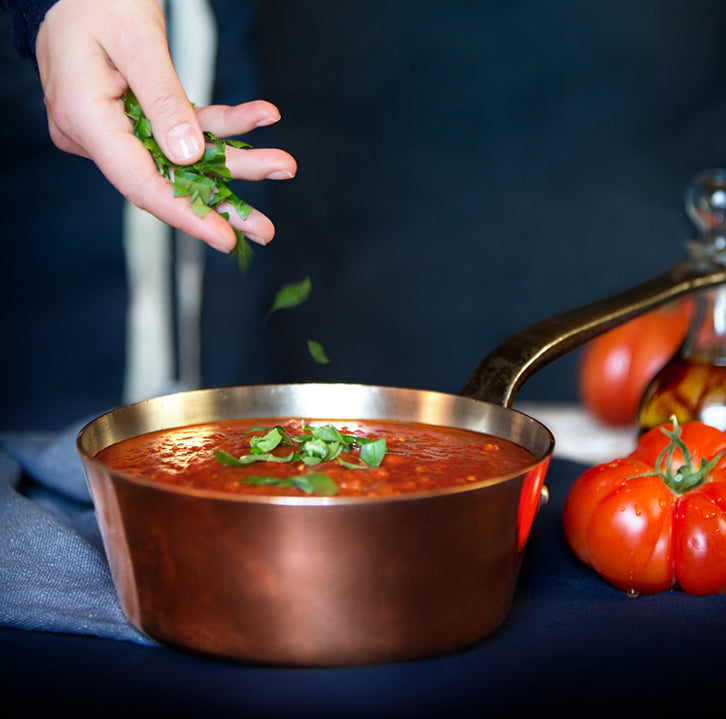
“We've specifically decided not to be consistent. We wanted to mix it up so it's not just rows and rows of similar looking products on white. For example, the blueberry jam is pictured on a spoon and actual blueberries around the jar because it’s a lot more inviting.”
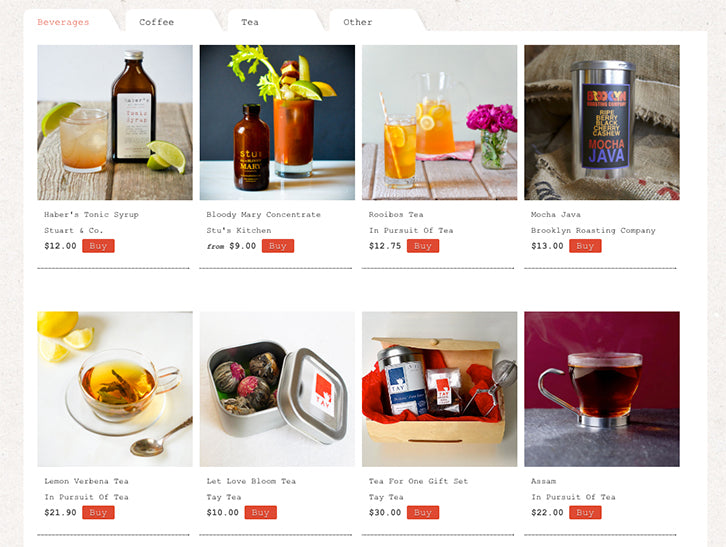
Photography is very, very important for food – you have to almost feel like you're tasting it.
Packagingis an important consideration while curating, but Valentina admits that she’s made an exception for some products that are just too good to pass up, despite ugly exteriors.
“We work with some producers who like our eye and our curation, and have come to us for help with their packaging and branding. We work with a wonderful designer in London who has helped us help other producers who need a little bit of an update on their design."
Community First
Valentina attributes much of her success to what she has learned from the community of producers.
“I did aTED talkbased on a quote that Claire Marin ofCatskill Provisionscasually said to me in conversation: ‘competition is so last century’. It became my ethos. We organized meet-ups with our producers where everyone was able to share their knowledge around the same challenges, whether it's getting into Whole Foods or figuring out inventory and warehousing. They could talk honestly with each other, because they weren't competitive. It was very collaborative.”
I really believe that we're more than the sum of our parts, and as a community we can all grow.
Get Physical
Most businesses can benefit from a littlecustomer face-to-face. How they interact with your product can help inform business decisions. Valentina gets IRL occasionally, as a great way to discover new products and meet emerging small producers.
“I've looked at spaces but the rent is just so astronomical and our margins are very, very small. We're not selling diamonds. We're selling $8 jars of jam. You'd have to sell a lot of jam to make rent in New York. Instead, we’ve done pop-up markets.”
“The pop-ups allowed me to meet great producers that are now on the site, and that I probably wouldn't have found otherwise. During the downtime, that was when we all sat around sharing ideas. It's lovely. The best part of any market is getting to know people.”

photo:Flickr
The Future of Fresh
In my urban neighbourhood, a farmers’ market sprouts up Wednesday afternoons during temperate months (which, in Canada, is about three). This inconvenient window means that I miss it most weeks, and frequently buy produce in the drug store’s inexplicable “fresh” grocery aisle.
I’m optimistic about the future, though. The way we grow and buy and consume food continues totrend in favour of small businesses and local farmers.
In New York, Valentina tells me, the future is now.
“Large, empty industrial buildings on the piers are being turned into markets for artisans or small batch producers, be it food or crafts. And they seem to be where everyone's going now. It'll be interesting to see what happens to grocery chains – I hardly go to the supermarket anymore.”



